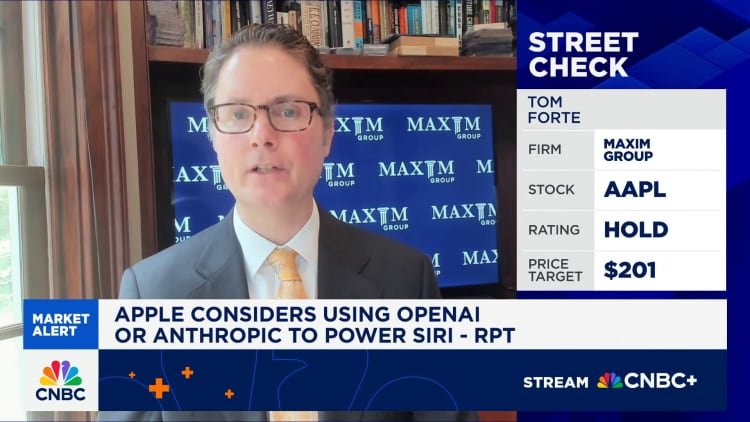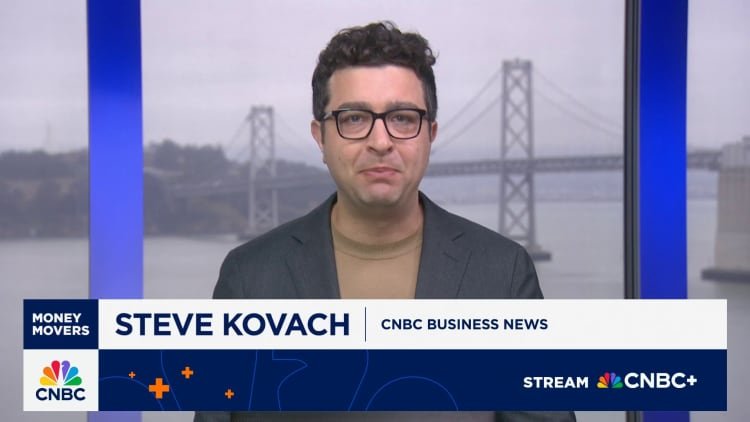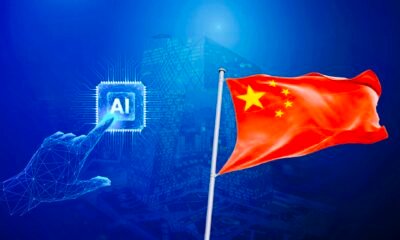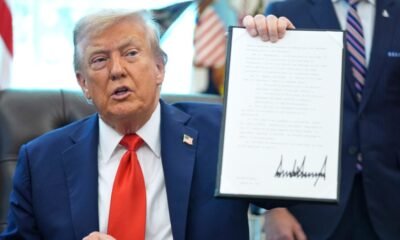Business
Apple is facing pressure from Wall Street to figure out AI strategy

Apple CEO Tim Cook and Senior Vice President of Software Engineering Craig Federighi speak during Apple’s annual World Wide Developers Conference at the company’s headquarters in Cupertino, California, U.S., June 9, 2025.
Laure Andrillon | Reuters
While its megacap tech peers are bragging about building island-sized data centers filled with Nvidia chips to power artificial intelligence devices of the future, Apple remains largely on the sidelines.
Wall Street is getting concerned.
The iPhone maker is the second-worst performer this year among the so-called Magnificent Seven, with its stock down over 15% as of Tuesday’s close. Tesla, down 20%, is the only other member of the group that’s lost value in 2025.
Apple has disappointed its users and investors by declining to share more about its AI strategy, despite delaying the next generation of Siri until at least next year. Making matters worse, longtime Apple design chief Jony Ive in May sold his nascent startup IO for $6.5 billion to OpenAI. In the announcement, OpenAI CEO Sam Altman said his company is currently working on new hardware devices.
OpenAI’s aggressive move underscores Apple’s unclear role in the future of AI and its lack of a clear strategy when it comes to competing. Analysts worry that Apple’s position could start to hurt iPhone sales, which are still happening in historic volumes.
“The incomplete AI strategy is still the biggest overhang, but we think Apple still has approximately 1.5 years to effect a compelling solution,” TD Cowen analyst Krish Sankar wrote in a note on Monday. He recommends buying the shares.
Don’t expect Apple to dwell on its AI problem when it reports fiscal third-quarter earnings on Thursday. The company will likely be too busy talking about the $40 billion in iPhones it’s expected to sell, per a FactSet estimate, and its profitable services business. Revenue in the services division is expected to show growth of about 11% to $26.8 billion, more than double the growth rate for the whole company.
Fortunately for Apple, it’s built quite the moat against the threat of AI due to high user satisfaction with its products and its ability to lock in customers who own multiple Apple devices. So while AI could threaten Apple’s spot as the most important computer hardware maker, the company has still got some time on its side.
Deepwater Asset Management founder Gene Munster says pressure for Apple in AI over the next year is minimized due to the ongoing strength of iPhones, Macs and the Apple Watch. And competitors like Google’s Android haven’t yet found a killer AI feature, Munster wrote in a recent report.
“With AI, the substance will exceed the hype, and this will be kind of a re-positioning, or a re-ranking of tech leadership,” Munster said in June. “It’s going to happen, but it’s not going to happen this next year.”
Apple has already lost an opportunity to capitalize on AI in the eyes of investors. In the summer of 2024, Apple released features that summarized emails and texts, generated images like emoji, and gave voice assistant Siri a visual redesign. It was collectively branded as Apple Intelligence.
However, the defining feature, a more versatile Siri, was delayed earlier this year until 2026.
Analysts initially hoped that the addition of Apple Intelligence might drive a “super cycle,” or prompt people who would have typically held off on upgrading their iPhones to purchase new devices for the AI features. But the increased sales never came.
“We haven’t seen that materialize in the way that the market had initially expected,” said Visible Alpha Research analyst Melissa Otto.
Apple declined to comment.
Challenging the smartphone
The vast majority of people who got a new iPhone last year did so because their current device was no longer working, according to a Consumer Intelligence Research Partners poll. Only 13% of people polled this year said they made the purchase for new features, including AI. When polling those who got new phones earlier this year, about 89% of U.S. iPhone owners choose to upgrade to another Apple device, the firm found.
Apple is keenly aware of the future risks. Eddy Cue, head of the company’s services business, said as much in a court case earlier this year.
“You may not need an iPhone 10 years from now, as crazy as it sounds,” Cue said.
Apple’s AI competition will likely come from two main sources. There’s Google, which offers Android devices, and AI-powered gadgets that might not even include screens, relying instead on different kinds of input, such as voice assistants.
OpenAI has announced plans to release the latter, and startups have played with new kinds of form factors, such as pins, pendants and smart glasses like the Ray-Ban Meta device.
Google has been aggressively integrating its Gemini assistant into Android. Users of Android 16, the latest version of the operating system that powers Samsung and other phones, can use Gemini to control apps, including Google Maps and YouTube. Users can ask Gemini to create to-do lists based on YouTube app tutorials — capabilities that are currently far beyond what Siri can do.
Still, even Google CEO Sundar Pichai is saying that it may be a few years before any AI-oriented device would challenge the smartphone.
“I still expect phones to be at the center of the experience for the next two to three years at least,” Pichai said during Alphabet’s earnings call last week.
Apple has to get more aggressive in the AI race, said Needham analyst Laura Martin, on CNBC last week. Martin said Apple is one to two years behind competitors, including Google, in artificial intelligence.
“If Android is going to integrate all the latest Gemini and generative AI, the next time you replace your iPhone — a year from now, two years from now — that Android ecosystem is going to have more and more cool stuff in it, and then Apple starts losing its installed base,” Martin said.
Jony Ive attends The Metropolitan Museum of Art’s Costume Institute benefit gala celebrating the opening of the “Superfine: Tailoring Black Style” exhibition on Monday, May 5, 2025, in New York.
Evan Agostini | Invision | AP
Perhaps Apple’s biggest challenger in AI hardware will be OpenAI with the addition of Ive, who is credited with helping to design and launch the iPhone, Apple Watch and other key products.
But OpenAI hasn’t given any timeline about its hardware launch, or even what it will be rolling out. It will likely take years before a product hits the market, and then the company has to figure out how to manufacture and ship hardware at scale.
When the iPhone was first announced in January 2007, it was a low-volume product for early adopters. Apple only sold 1.4 million iPhones in the first year, most of them in the fourth quarter, a tiny fraction of the more than 1.15 billion mobile phones sold that year, of which over 435 million were Nokia devices. Apple didn’t introduce the App Store until 2008.
Four years later, Apple’s unit sales had passed Blackberry maker RIM, as well as HTC, an early Android phone maker, and Motorola. By 2011, Nokia’s sales had nosedived, and Apple had grown its business to sell more than 80 million iPhones per year.
Munster predicts that OpenAI’s device will likely be unveiled next year and would start shipping to customers in 2026. Apple has some time, but the clock is ticking.

Business
First the great migration, now the big hold: why workers are staying put | US small business

The tide has turned. The great migration – when the shift to remote work prompted people to quit their jobs in droves – is officially over. Now comes the big hold.
According to a new survey from consulting firm Robert Half, 73% of respondents – workers at companies – said they plan to stay in their current roles through 2025. They gave reasons like having “positive company culture” and “feeling professionally fulfilled” or “being well compensated” at their current job. But there’s also a fourth reason why so many are staying put: the job market isn’t great and people are worried.
Job growth is significantly down. Job openings fell again to under 7.5m last month, a level that’s 4m below the openings available back in 2022. Wage gains during that same period had fallen from 6.7% to 4.1%.
Microsoft, AT&T, JP Morgan, Amazon and other companies are mandating their employees to return to their offices or lose their jobs. AI is already replacing workers at tech companies, Wall Street firms and retailers and some fear greater job losses in the not too distant future. Other cost cutting measures are leading big brands like Citi, Accenture, Tesla and Intel and other corporate giants to lay off tens of thousands of workers.
And what a great opportunity for small businesses!
For example, there’s my friend in Illinois. He has over 100 employees in his office. For years, he’s been spending half his days just walking around and talking to them. Telling them how important they are. Checking in on their lives and families. Asking them what they’re doing and what problems they’re having. Imagine working for that guy. Someone who genuinely cares about his workers. His turnover’s low. His retention is high.
Or another client of mine in Pennsylvania who allocates a big piece of his operating budget every year to employee technical training. Fear AI? “No way”, he tells me. “I want my people to embrace it! They need to learn about all the AI features in our software applications so that they can not only get more work done for me during the day but have a more balanced life themselves.” Did I mention that he gets workforce development money from his state that pays for this extra training? Now you know.
Another client of mine gives employees a $1,000 educational “credit” to use however they want. “They can learn origami or take a knitting class for all I care,” she said to me. “Becoming a better person makes you a better worker too.” Not coincidentally, she also enjoys the tax deductions allowed for providing this benefit.
There are other tax benefits that small business owners can use to recruit and retain all this available talent for healthcare, childcare, for hiring workers who were formerly incarcerated, off welfare or out of the military.
In the midst of all this job chaos, small business hiring and employment has remained constant. The latest Small Business Employment Watch report from Paychex, the giant HR and payroll processing firm, found that in July hiring among those companies with less than 50 employees “remained steady” which, according to the company’s CEO “speaks to the resiliency of small businesses given the amount of uncertainty they faced so far this year”.
Ever since I can remember my small business clients have complained about competing with big companies and the government for talent. Well, now the tide has turned. Big companies are laying off people by the tens of thousands. Governments are cutting their headcounts. The labor market is softening. But small businesses – who already employ half of this country’s workers – are still hiring and always looking for talent. The softening job market is a great opportunity for them. And for many workers.
Business
Wytham Abbey’s asking price slashed by 60% after failure to find buyer | Property

Wytham Abbey, a 15th-century grade I-listed manor that was once planned as a hub for technologists and philosophers to solve some of the world’s toughest problems, has had its sale price slashed by 60% to £5.95m as its charity owners struggle to find a buyer.
The Effective Ventures Foundation (EVF), formerly the Centre for Effective Altruism, bought the 27-bedroom, 18-bathroom Oxfordshire estate in April 2022.
Backed by the Facebook co-founder Dustin Moskovitz’s Open Philanthropy fund, EVF envisioned the property as a hub for global thinkers combining effective altruism and artificial intelligence to “benefit others as much as possible”.
But it was forced to put the manor and extensive grounds up for sale for £15m last year after its backers withdrew support for the events venue.
The property portal Rightmove said it was one of its five most-viewed homes of 2024 but with no sale agreed the asking price was reduced to £12m in June. It was cut again in August with the UK’s luxury property market struggling amid cooling interest from the world’s super rich and Labour’s tax changes.
EVF said: “As part of its ongoing effort to maximise sale proceeds directed to high-impact charities, Effective Ventures has taken advice from leading surveyors and decided to lower the property’s guide price to encourage offers from actively interested prospective buyers.”
Savills, the agency marketing the property, declined to comment.
Over its six centuries, the abbey has welcomed an eclectic list of guests, from Queen Elizabeth I, Oliver Cromwell and Queen Victoria to Skype’s billionaire investor, Jaan Tallinn, and the jailed FTX founder, Sam Bankman-Fried. FTX was an EVF backer before its collapse.
Set in 9 hectare (23 acres) of grounds and parkland and built around 1480 from locally quarried limestone, it retains Tudor arched doorways. The Earl of Abingdon lavished money on improvements in the 18th century, adding to its grandeur. It has eight reception rooms, a Georgian-oak staircase, stained glass panels and a marble fireplace.
after newsletter promotion
At the time of its decision to sell the property, an EV spokesperson said: “Effective Ventures agreed with the abbey’s major donors at the time of the original purchase that they could recommend that EV sells the property if they believed there were higher-impact uses of the asset.”
EVF’s parent group, Effective Ventures, repaid nearly $27m (£20m) last year to the FTX estate – equal to all the funds it received from entities linked to Bankman-Fried. He was sentenced to 25 years in prison in March 2024 for defrauding customers and investors of his crypto empire, which collapsed into bankruptcy from a valuation of $32bn.
Business
How Trump and corporations have hobbled US labor watchdog | Business

Jennifer Abruzzo, general counsel for the National Labor Relations Board (NLRB) under the Biden administration, was one of the first officials to be fired by Donald Trump once he took office in January. She wasn’t the last.
Since then, Trump has fired a slew of government officials, including the National Labor Relations Board (NLRB) chair, Gwynne Wilcox, the Bureau of Labor Statistics commissioner, Erika McEntarfer, and most recently, he has attempted to fire the Federal Reserve governor Lisa Cook.
Abruzzo served at the agency for nearly 30 years before Trump fired her in January 2025, a move recommended in Project 2025. Now she is warning that the attacks on the US’s top labor watchdog threaten to return workers’ rights to levels unseen since 1935 and empower corporations to run roughshod over the agency.
“My fear is that if this continues, where corporations and corporate billionaire donors have an outsized voice and directly influence our democracy, we’re going to find ourselves living in an environment such as what we lived in before 1935 when the National Labor Relations Act was enacted,” said Abruzzo. “Working families will be dealing with lower wages, substandard working conditions, and no real channels for them to fight back.”
In May, the supreme court declined to reinstate Wilcox while she challenges Trump’s decision to terminate her without cause. A lower court will now have to rule on the issue, with the supreme court likely to follow on appeal. In the meantime, the agency’s powers have been effectively blocked and, Abruzzo worries, worse may be to come.
The move was seen by opponents as a challenge to a landmark 1935 case, Humphrey’s Executor v United States, that ruled Congress can limit the president’s power to remove officials from independent administrative agencies.
Abruzzo worries that Wilcox’s firing could pave the way for the National Labor Relations Act, enacted in 1935 to federally protect workers’ rights to organize and engage in collective bargaining, to be repealed entirely.
“If the supreme court majority eliminates or limits the reach of Humphrey’s Executor and allows the president to fire decision-making officials in the executive branch, including at the NLRB, at his whim, then I anticipate the next step will be figuring out whether or not, if they are found unconstitutional, those provisions should be severed, or the whole [NLRA] act could conceivably be repealed,” Abruzzo said.
In the meantime, Abruzzo argues, the NLRB has been rendered toothless.
“It’s going to take years to sort out, the agency’s going to be completely ineffective in enforcing the statute, and working families are going to continue to suffer and not be able to get any redress for the violations of their rights. It’s why I think states need to step in and protect their citizenry.”
Major corporations are already making ground against the agency after the ruling. On 19 August, the US court of appeals fifth circuit ruled preliminary injunctions halting unfair labor practice cases against Elon Musk’s SpaceX and two other employers can remain in place as the employers’ challenge the constitutionality of the NLRB.
The NLRB declined to comment. SpaceX did not respond to multiple requests for comment.
“I think we’re going to see a flood of employers forum shopping and flocking into district courts in the fifth circuit area seeking to get preliminary injunctions preventing the NLRB cases that frankly are seeking to hold corporations accountable for their law breaking from moving forward, and that’s going to put an end to the NLRB being able to enforce the act in any meaningful way,” said Abruzzo. “This is all about elevating corporate interests above workers’ rights.”
The firings have also left the NLRB without a quorum throughout most of the Trump administration, rendering it unable to issue decisions on cases.
In January 2025, after Trump fired Wilcox, the first Black woman to serve as chair of the NLRB board. Trump nominated two members to the board. They are awaiting a vote in the Senate for confirmation, while the term of one of two remaining board members, Marvin Kaplan, expired on 27 August.
The agency has also proposed a 4.7% budget cut of $14m for fiscal year 2026, after noting the agency expects to lose nearly 10% of its staff to voluntary resignation and early retirements.
The acting general counsel of the NLRB argued earlier this month that the board “has largely been unaffected” by the lack of quorum. But since Trump took office, the NLRB has only issued six decisions compared with fiscal year 2024, when the board issued 259 decisions.
“Unless an employer is willing to go along with what the board says, the employer can stall a case indefinitely right now,” said Lauren McFerran, who served as chair of the NLRB during the Biden administration and as a board member from December 2014 to December 2019 and again in July 2020 to January 2021.
“So whether it’s a [union] election case, whether it’s an unfair labor practice case, the minute the employer says that they’re not willing to go along and that they want to raise an objection to the board, you’re stuck for the foreseeable future at this point,” added McFerran.
Abruzzo argues the firing of Wilcox by Trump, if allowed to stand by the courts, would eliminate the independence of the NLRB in favor of corporations. It’s up to the public to push back on these trends of stripping away protections for workers at the behest of wealthy, powerful corporations and billionaires like Musk, she said.
“There is strength in numbers, and we all need to remember we matter. We make an impact on each other’s lives each and every day, and we can’t let the voice of corporate billionaires drown out our voices or squelch our actions and our spirit,” said Abruzzo.
“We’re not powerless, and we have the power to demand changes to the way we’re governed, to the way we live our lives. That includes taking to the streets, frankly, and protesting over inadequate wages and working conditions and over economic, social and racial injustice. We need to do more in amplifying our voices, to make sure we’re heard and that actions are taken that are going to benefit us, because that’s, in my opinion, how the tactic of divide and conquer is going to be vanquished.”
-
Tools & Platforms3 weeks ago
Building Trust in Military AI Starts with Opening the Black Box – War on the Rocks
-

 Ethics & Policy1 month ago
Ethics & Policy1 month agoSDAIA Supports Saudi Arabia’s Leadership in Shaping Global AI Ethics, Policy, and Research – وكالة الأنباء السعودية
-

 Business2 days ago
Business2 days agoThe Guardian view on Trump and the Fed: independence is no substitute for accountability | Editorial
-

 Events & Conferences3 months ago
Events & Conferences3 months agoJourney to 1000 models: Scaling Instagram’s recommendation system
-

 Jobs & Careers2 months ago
Jobs & Careers2 months agoMumbai-based Perplexity Alternative Has 60k+ Users Without Funding
-

 Funding & Business2 months ago
Funding & Business2 months agoKayak and Expedia race to build AI travel agents that turn social posts into itineraries
-

 Education2 months ago
Education2 months agoVEX Robotics launches AI-powered classroom robotics system
-

 Podcasts & Talks2 months ago
Podcasts & Talks2 months agoHappy 4th of July! 🎆 Made with Veo 3 in Gemini
-

 Podcasts & Talks2 months ago
Podcasts & Talks2 months agoOpenAI 🤝 @teamganassi
-

 Jobs & Careers2 months ago
Jobs & Careers2 months agoAstrophel Aerospace Raises ₹6.84 Crore to Build Reusable Launch Vehicle





















